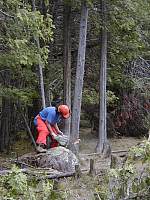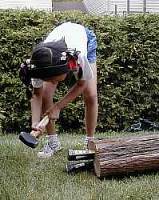
 |
 The
wooden part of a birchbark canoe are almost all made of cedar. In the east,
this is Eastern White Cedar, Thuja occidentalis. Cedar grows in swampy
areas and on shallow dry soil and averages about 45 ft in height and 1 ft in
diameter. Large trees may grow to 3 feet in diameter. It often grows in dense
clumps. The wood is good for canoe building because it is light in weight, easy
to split and bend and resistant to decay.
The
wooden part of a birchbark canoe are almost all made of cedar. In the east,
this is Eastern White Cedar, Thuja occidentalis. Cedar grows in swampy
areas and on shallow dry soil and averages about 45 ft in height and 1 ft in
diameter. Large trees may grow to 3 feet in diameter. It often grows in dense
clumps. The wood is good for canoe building because it is light in weight, easy
to split and bend and resistant to decay.
Cedar trees are common where I live in Ontario but finding good cedar for a canoe is not easy. It must be straight and knot free and big enough around to make useful pieces. To see if the grain is straight, peel off a strip of bark vertically, and see if it goes up straight or curves around the tree. If the bark curves, then the wood inside will too. Knots are to be avoided because they weaken the wood.
Cedar is used for the gunwales, ribs and sheathing in the canoe. The longest pieces are the gunwales so a tree that is sufficiently long and straight must be found for them. For the ribs and sheathing, pieces that are about 5 feet long are long enough. I found some nicely cut logs that were being removed from an area where a road was being put through. I also was able to cut a couple of trees from my friend Dale's property. My friend Noreen (in the red hard hat) brought her chain saw to cut those trees.
 A
cedar log is split rather than sawn into pieces. I think this makes the wood
much stronger since you are following the grain. Also, it requires few tools.
A cedar log is split green. It is first split across the growth rings:
lengthwise down the middle into two halves, then again into quarters and depending
on how big the log is, again into eighths. Here's my neighbour Jean starting
to split a cedar log with two metal splitting wedges and a sledgehammer. She's
wearing ear protectors because it's quite noisy.
A
cedar log is split rather than sawn into pieces. I think this makes the wood
much stronger since you are following the grain. Also, it requires few tools.
A cedar log is split green. It is first split across the growth rings:
lengthwise down the middle into two halves, then again into quarters and depending
on how big the log is, again into eighths. Here's my neighbour Jean starting
to split a cedar log with two metal splitting wedges and a sledgehammer. She's
wearing ear protectors because it's quite noisy.
Then the split pieces are split along the growth rings to make flatter pieces. The ribs are split roughly to shape, then finished with an axe, knife or other tools. The sheathing is split very finely until it is barely the thickness of a piece of thin cardboard. Splitting cedar is a wonderful process. It smells nice and sounds neat.
 The
initial splitting is done with splitting wedges, then an axe and a mallet can
be used to start the split and the rest done by pulling the pieces apart with
your hands. For the fine splitting, a knife is used to start the split. Getting
cedar to split evenly must be practised a bit but is not hard if the wood is
straight. If the split starts to go off centre, pull a bit more on the thicker
side. In this picture I am starting a split with a hatchet, holding the wood
between my legs to control the split.
The
initial splitting is done with splitting wedges, then an axe and a mallet can
be used to start the split and the rest done by pulling the pieces apart with
your hands. For the fine splitting, a knife is used to start the split. Getting
cedar to split evenly must be practised a bit but is not hard if the wood is
straight. If the split starts to go off centre, pull a bit more on the thicker
side. In this picture I am starting a split with a hatchet, holding the wood
between my legs to control the split.
Before I actually began to build my canoe I prepared the ribs (plus some extras in case I broke some) and pieces for sheathing. These are thin pieces that are laid inside the canoe under the ribs.
Back to the Materials page
© Judy Kavanagh 2001